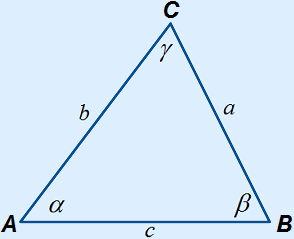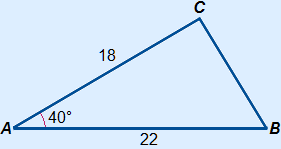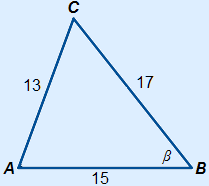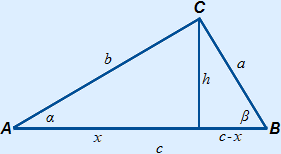Trigonometry » Law of cosines
Note: The length a and the angle size α (alpha) are used both, look closely at the difference between the two letters.
Contents
What is the law of cosines?How do you calculate with the law of cosines?
Proof of the law of cosines

What is the law of cosines?
The law(s) of cosines for triangle ABC in which α =  A, β =
A, β =  B, γ =
B, γ =  C, a = BC, b = AC and c = AB is:
C, a = BC, b = AC and c = AB is:
a2 = b2 + c2 – 2bc cos(α)
b2 = a2 + c2 – 2ac cos(β)
c2 = a2 + b2 – 2ab cos(γ)
How do you calculate with the law of cosines?
With the law of cosines you can calculate the third side when you know two sides and the angle in between. You can also calculate the angles when you only know the three sides.
Example 1
Given is the following triangle. Calculate the unknown length.

Answer:
We have to calculate a so we use a2 = b2 + c2 – 2bc cos(α)
Filling in the equation and solving it gives:
a2 = 182 + 222 – 2 × 18 × 22 cos(40°) ≈ 201.29...
a = BC =  ≈ 14.2
≈ 14.2
Example 2
Given is the following triangle. Calculate β.

Answer:
We have to calculate β so we use b2 = a2 + c2 – 2ac cos(β)
Filling in the equation and solving it gives:
| 132 = | 172 + 152 – 2 × 17 × 15 × cos(β) |
| 169 = | 514 – 510 cos(β) |
510 cos(β) = | 345 |
cos(β) = | 345510 |
| β = | 47.4° |
Proof of the law of cosines
To prove the law of cosines, we use an altitude.

The length of x can be calculated as follows:
x = b cos(α)
Because of Pythagoras' theorem the following is also true:
h2 = b2 – x2
h2 = a2 – (c – x)2
Therefore:
| b2 – x2 = | a2 – (c – x)2 |
| b2 – x2 = | a2 – (c2 – 2cx + x2) |
| b2 – x2 = | a2 – c2 + 2cx – x2 |
| b2 = | a2 – c2 + 2cx |
| b2 – a2 = | –c2 + 2cx |
| –a2 = | –b2 – c2 + 2cx |
| a2 = | b2 + c2 – 2cx |
When we substite x for b cos(α) we will get:
a2 = b2 + c2 – 2bc cos(α)